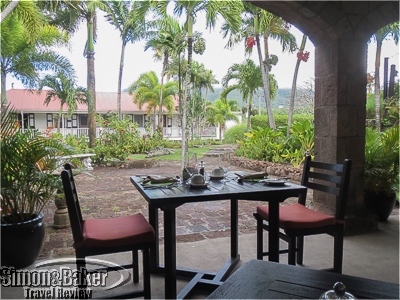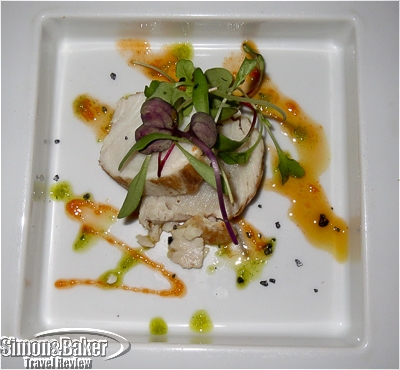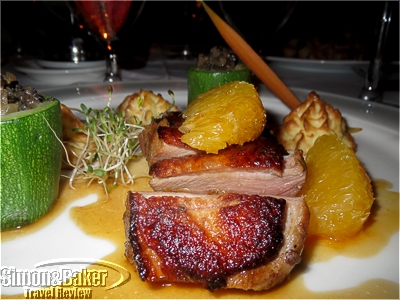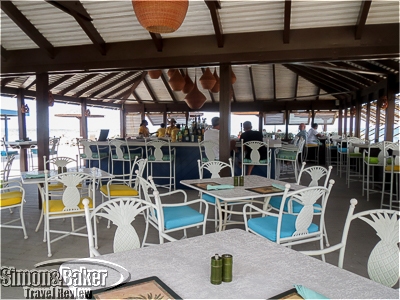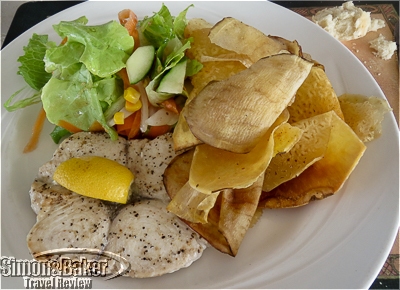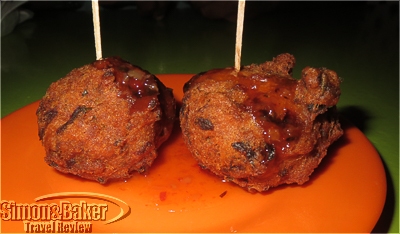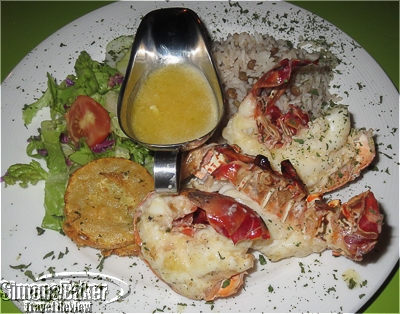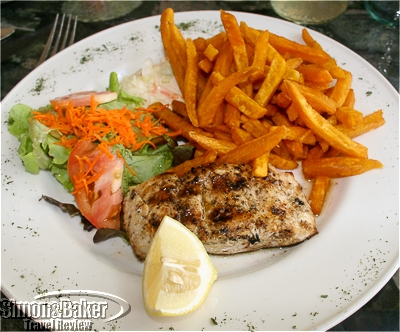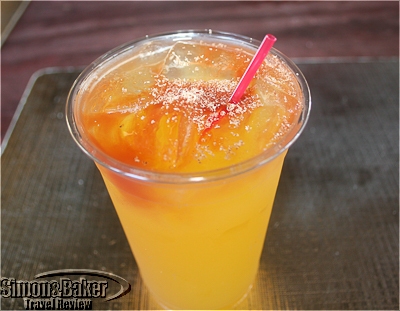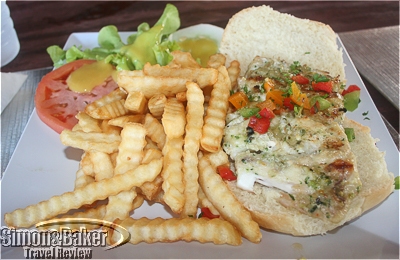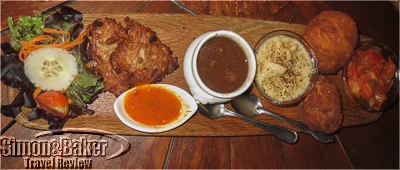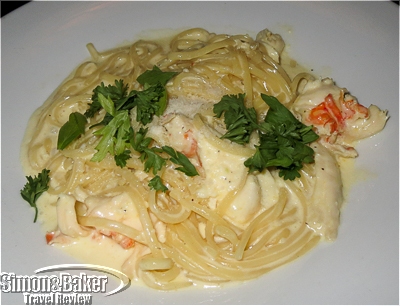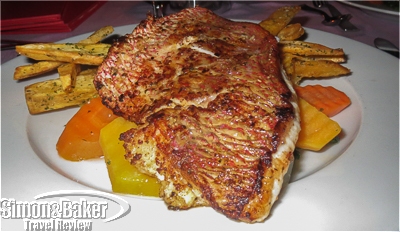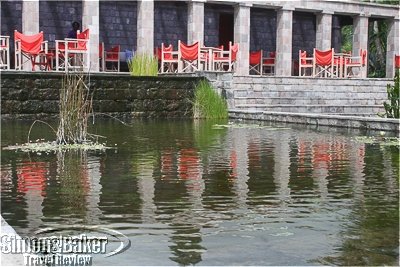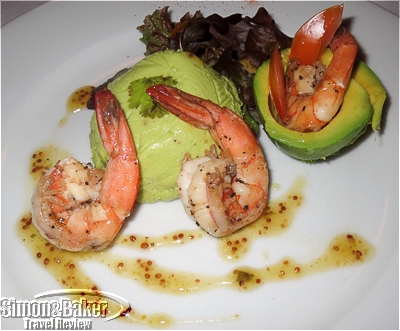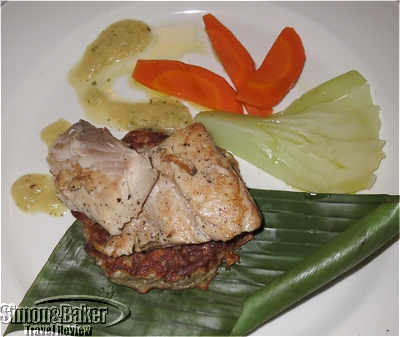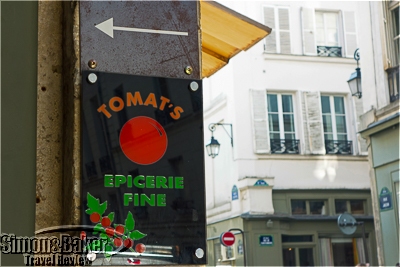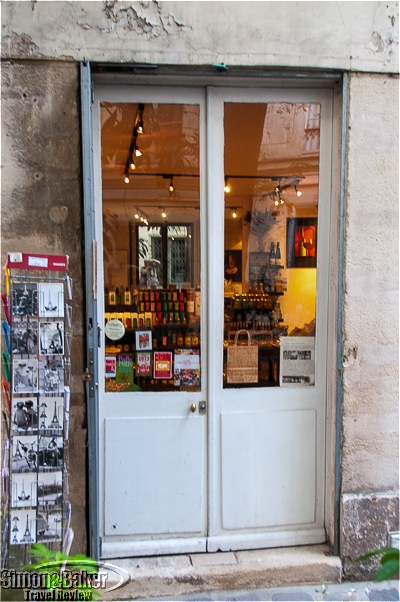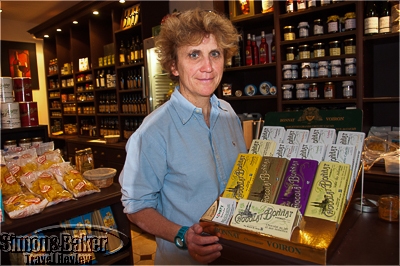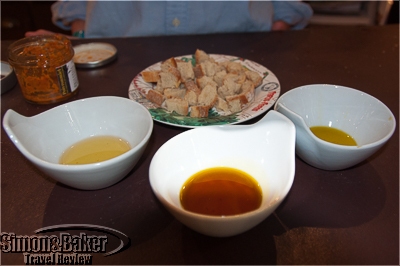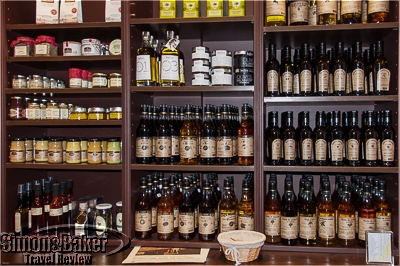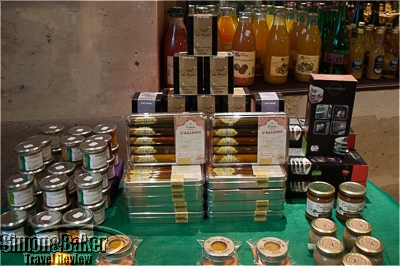Luxury Travel Review

Greece revisited, adventure road travel through the Pindus Mountains
Article and photos by Josette King
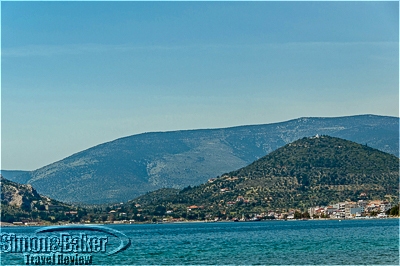
The Gulf of Corinth
I thought I knew Greece. I had visited a couple of its legendary islands and snorkeled in the crystalline waters of its rocky coves. I had stayed in Athens long enough to explore most of its nearby ancient ruins. I had enjoyed the taverna food and the street musicians playing their ornate nine-string bouzouki. And I had learned to stay clear of ouzo, the fiery local brew. So, yes I thought I knew Greece. Until I came across an eight-day Tripology Adventures itinerary from Athens to the Pindus Mountains with overnight stops in Delphi, Ano Chora, Karpenisi, Kalampaka and back to Athens.

Columns of the temple of Apollo in Delphi
Tripology is an adventure travel company that has been leading self-drive caravans of all-wheel drive vehicles into remote history-rich areas of the planet for over two decades. The Pindus Mountain Range, the vast backbone of peaks, valleys and gorges that traverses the Greek mainland from the northwest to the southeast definitely fit that profile. It is covered with forests so impenetrable that its central region, the Agrafa (Greek for unchartered), succeeded in maintaining its autonomy throughout the four centuries of Ottoman occupation of the country, becoming a refuge for the fiercely independent souls who wanted to escape the oppressors. That wild, sparsely inhabited region has remained relatively pristine to this day. Most of the roads that wind their way up and down its steep slopes are still unpaved. That was a unique opportunity to venture on terrains that I knew better than to attempt on my own and explore a Greece I hadn’t realized still existed.

Statuary from the Delphi Archeological site now on display in its museum
Our five-vehicle convoy left Athens on a sunny spring morning, four late model 4 x 4 vehicles packed with eager adventurers, 14 of us in all, following the lead land cruiser with our guide, Yoav Barashi, a seven year veteran of Tripology tours in the area. Our lead driver Nikos Manolis, an expert all terrains driver, was also a noted figure in the Greek rally community. The highlights of the first day, a relaxed seaside lunch on the Gulf of Corinth and a privately guided tour of the archeological site of Delphi, were a pleasant nod to familiar Greece, and an ideal opportunity for us to get acquainted with our traveling companions and our vehicles.
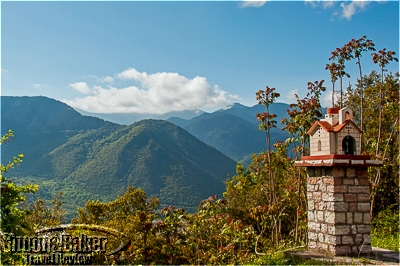
Tiny roadside shrines were a frequent sight
The next morning, the roller-coaster ride that was to become the norm for our entire 1,200 kilometer trip began in earnest as we negotiated Bauxite Way. The 24 kilometer (15 mile) uphill strip of gravel and tight turns is one of the best known stages of the Acropolis Rally of Greece, named after the nearby aluminum ore mine and the prevalent red dust. After the exhilarating driving experience followed by a break at the shaded terrace of a village taverna, we were on our way again. That time we climbed up a rough unpaved trail that hugged the rock face and curved incessantly upon itself on our way to a mountaintop picnic. Our lunch scenery was a jaw-dropping view of densely forested canyons and craggy peaks. Then after an equally tortuous descent we ended up at a rustic village inn for the night.
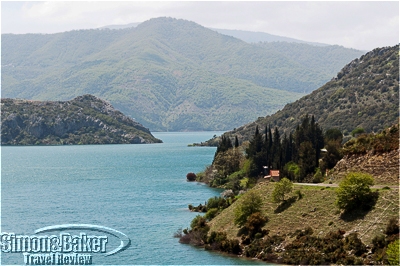
Lake Mornos
Day after day, as we drove deeper into the Pindus and entered the Agrafa area, the mountains became higher, the canyon deeper and the trails hewed out of the rock more forbidding. Those dramatic vistas bursting with the colors of spring were a photographer’s paradise. Each turn revealed a better view of snow capped peaks, a turquoise lake sculpted by canyons in the shape of a giant octopus or a hill dotted with the purple blooms of Judas trees. Tiny roadside shrines were a frequent sight, presumably meant to petition for divine protection on behalf of intrepid travelers or offer thanks for road catastrophes avoided as much as to mark the spot of one that had been.
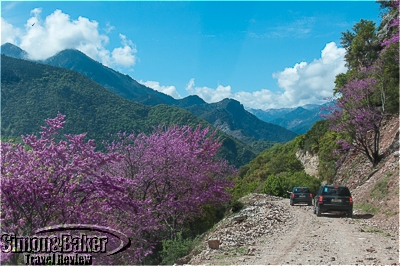
The mountain roads were lined with Judas trees in full bloom
We could drive for hours without seeing a sign of human life, much less another car. Then a shepherd with his flock of long haired sheep appeared, or a herd of goats plundering the high grass at the edge of road or beekeepers tending their hives. One more bend in the road would reveal a village of sturdy stone houses stacked against the mountain, and blending into the rock. We would stop in the central platia, the village square at the heart of every Greek village bookended by the ubiquitous taverna on one side and the village church on the other. Even the smallest of churches was a treasure trove of gilded icons and byzantine style frescoes.
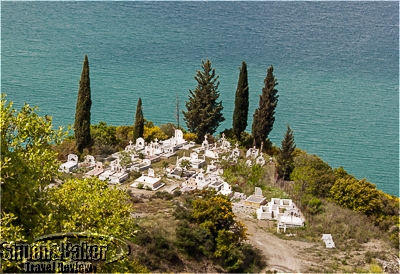
Cemetery on the shore of Lake Kremaston
Our guide Yoav was remarkable for his extensive knowledge of the region and also for his passionate interest in it, which he shared over our two way radio channel. He brought places and events into human context, shedding light on a vibrant and often tragic history that is little more than a footnote in western history books. He was equally knowledgeable of the tales of Greek mythology, mimicking to great effect the foibles of Zeus, Apollo, Hermes and even Aphrodite or Psyche. Had my high school history teacher possessed a fraction of his story telling talent, I might have been an ancient Greece scholar today.
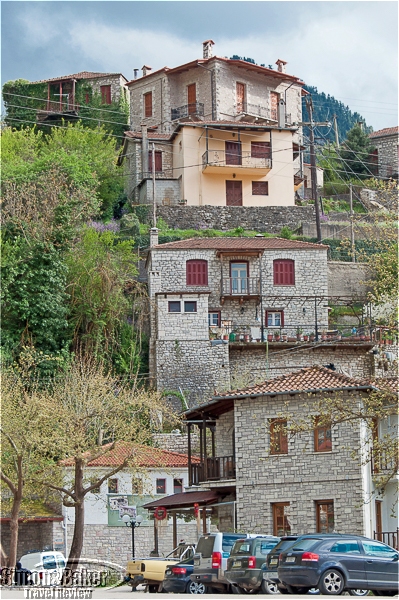
Villages were stacked against the hillsides
Do I know Greece now? I do, a little better at least. But more importantly, thanks to this road journey, I fell in love with the country. I now yearn to return at the first opportunity. And best of all, I so enjoyed the Tripology Adventures way of exploring new horizons that I am already searching their destinations for my next road adventure.
Some of our favorite Paris bakeries and sweets and chocolate shops
By Elena del Valle and photos by Gary Cox
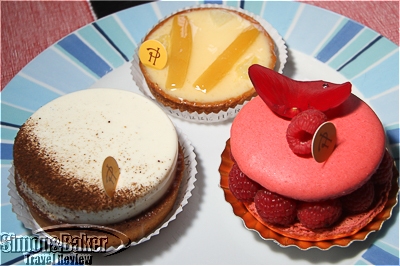
Delicious Pierre Hermes desserts
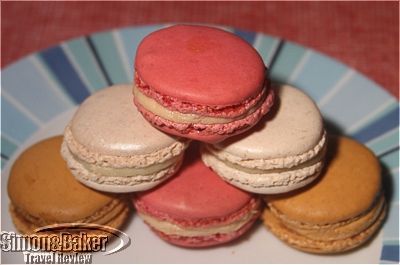
Caramel salted butter, white truffle, tangerine and rose macarons
For many years we have sampled baked goods and chocolates in various neighborhoods in the City of Lights with mixed results. Our tastings and discoveries have led us to a few favorites we return to whenever we are in Paris, France. For example, we like the Pierre Hermes shop on rue Bonaparte in the Latin Quarter. We have been there many times over the years (see Paris macaron maker remains a favorite). It has been our experience that while the shop is small and often crowded the staff members are friendly and efficient. We find the pain au chocolat, Ispahan croissants, Infiniment Vanille tart and single flavor macarons worth hoofing it there from nearby neighborhoods. Our preferred macaron flavors have been caramel salted butter, white truffle, rose and tangerine. Recently, we also sampled the Ispahan Gaufre, a soft cookie sandwich with a waffle like appearance and rose and raspberry filling sold in a single sealed sleeves. In addition to the taste we liked the Gauffre’s slightly longer shelf life compared to the fresh baked goods which only lasted a few days.
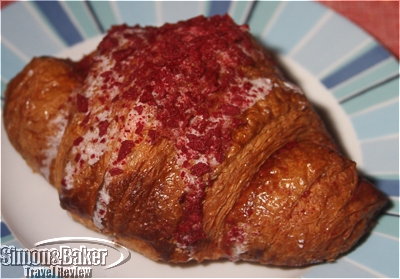
The Isbahan croissant became a new favorite.
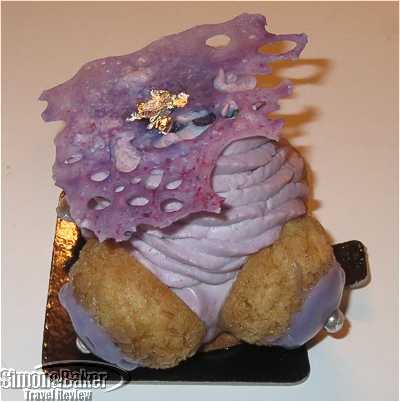
The Lilly Valley from Carl Marletti
In the Left Bank, we liked the vanilla eclairs at La Parisienne bakery on rue Monge. When we were in the mood for our favorite vanilla eclairs we went to Carl Marletti on rue Censier. It was also home of the Lilly Valley, another favorite pastry worth a special trip. It was best to arrive early in the day to avoid leaving empty handed as they sometimes sold out of the Lilly Valley. In the Right Bank, the vanilla eclairs at Stohrer on rue Montorgueil, said to the be oldest bakery in the city, and the mini pain au chocolat were worth a stop.
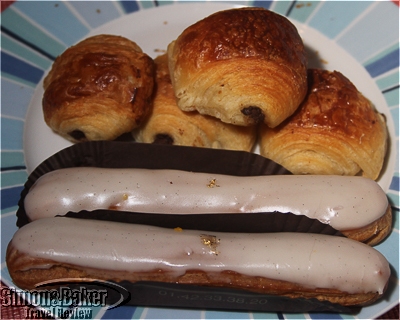
Vanilla eclairs and mini pain au chocolat from Stohrer
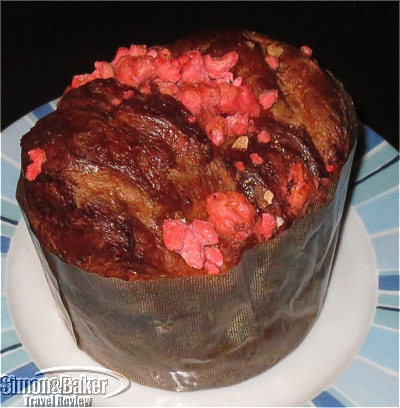
Praline bread from Eric Kayser
We walked to the Eric Kayser bakery on rue Monge for its good cereal baguette and moist mini financier pastries. For small brioches with praline that remind us somewhat in texture and flavor of Hawaiian bread we made our way to the shop on rue des Petits Careaux at the top of rue Montergueil.
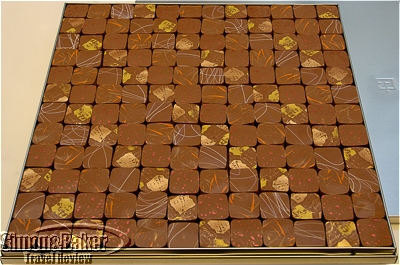
Jacques Genin chocolates
For exceptional candy including artisan marshmallows, marron glaces and candied chestnuts (smaller than the marron glaces) in season, and pate de fruit from the Basque Region we popped into Bon Bon au Palais on rue Monge. If craving delicate chocolate bites we headed to Jacques Genin on rue de Turenne on the Right Bank (see Passionate chocolate, candy maker draw to Paris Marais shop) or the new Left Bank location on rue de Varenne (see Paris chocolate, candy maker opened new Left Bank shop).
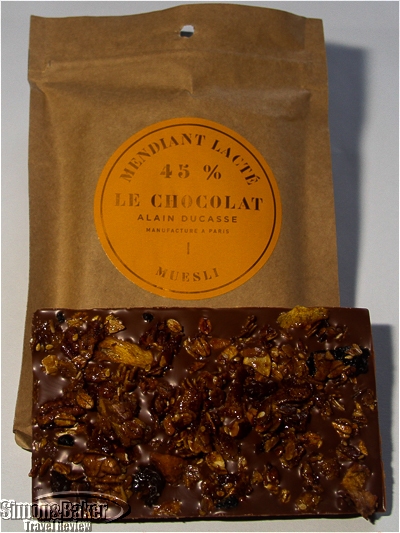
Mendiant chocolate bar from Manufacture
For hearty extraordinary single source chocolate bars we loved the new Alain Ducasse Manufacture shop on rue Saint Benoit in the Left Bank (see Alain Ducasse new Left Bank shop worth a visit for single source dark chocolate). While smaller than the original shop and manufacturing facility on rue de la Roquette on the Right Bank (see The art of making chocolate Alain Ducasse style in Paris) it had the same products on offer. The staff members we met were well informed, service oriented and helpful. In a pinch we would consider the Manufacture stand at the Gallery LaFayette Gourmet store, but only if we happened to be in that area.
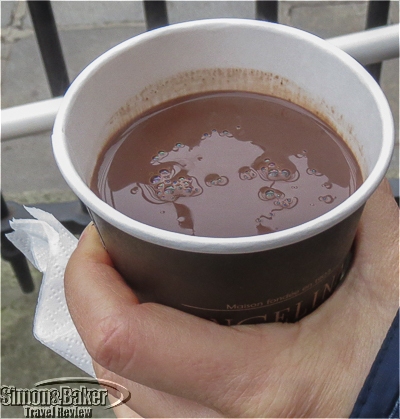
Thick chocolate to go from Angelina
Our favorite way to enjoy hot chocolate was to buy a cup of take out from the Angelina Cafe on rue de Vaugirard on the Left Bank next to the Luxemburg Museum. Served pipping hot it had a dark rich tart flavor that drew us back over and again. The only down side was the take out came without the whipped cream. The rue de Rivoli main shop (and salon) on the Right Bank also sold the hot chocolate to go, but the one time we tried it the hot chocolate was sweeter, milkier and missing the tart finish we liked so much.
New Tanzania mammals field guide available

*A Field Guide to the Larger Mammals of Tanzania
Safari goers headed to Tanzania may be interested to know that a new field guide highlighting 135 species of larger mammals (60 percent of mammals identified in Tanzania are rodents, bats and shrews), ranging in size from the hedgehog to the humpback whale, was published. The East Africa country is best known among game viewing and nature enthusiasts for the Serengeti National Park, Ngorongoro Crater, and Mount Kilimanjaro.
Part of the WildGuides, A Field Guide to the Larger Mammals of Tanzania (Princeton University Press, $29.95) by Charles Foley, Lara Foley, Alex Lobora, Daniela De Luca, Maurus Msuha, Tim R. B. Davenport and Sarah Durant is a 320-page paperback book published in 2014. It includes 300 color illustrations and 140 maps. The book is the second in the Wildlife Conservation Society (WCS)-Tanzania Programme field guide series. Author royalties from the book are to be donated to the Wildlife Conservation Society to support the Tanzania Carnivore Project or other wildlife projects in the country.
Forty percent of Tanzania’s larger mammals are strictly or mostly nocturnal, requiring night drives or walks for optimum viewing. The authors recommend red colored filters during those hours.
For land animals there is information on identification, subspecies, similar species, ecology, behavior, distribution, conservation status, and where best to see each type of creature. The conservation status categories are: Critically Endangered, Endangered, Vulnerable, Near Threatened, and Least Concern. There are also plates with side-by-side photographic comparisons of species that are easily confused, and first-time-ever species checklists for the national parks.
Charles Foley is assistant country director for the Wildlife Conservation Society in Tanzania. Lara Foley is program manager of the Wildlife Conservation Society’s Tarangire Elephant Project. Alex Lobora is senior research officer at the Tanzania Wildlife Research Institute. Daniela De Luca is senior scientist for the Wildlife Conservation Society’s conservation programs in the Southern Highlands of Tanzania and Zanzibar. Maurus Msuha is head of wildlife information and education at the Tanzania Wildlife Research Institute. Tim R. B. Davenport is country director for the Wildlife Conservation Society in Tanzania. Sarah Durant is senior research fellow at the Zoological Society of London’s Institute of Zoology.
*Photo: Princeton University Press
What we liked about dinner at Vinland in Portland, Maine
By Elena del Valle
Photos by Gary Cox
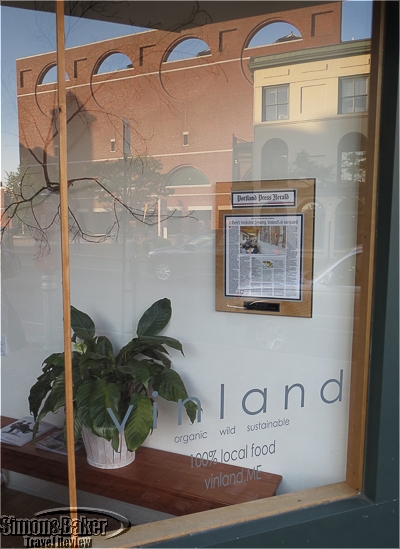
The front window of Vinland faces the Portland Museum of Art
The theory of locally sourced gourmet meals offered by Vinland restaurant in Portland, Maine appealed to us. Wondering how well theory translated to practice we made dinner reservations. We were pleasantly surprised.
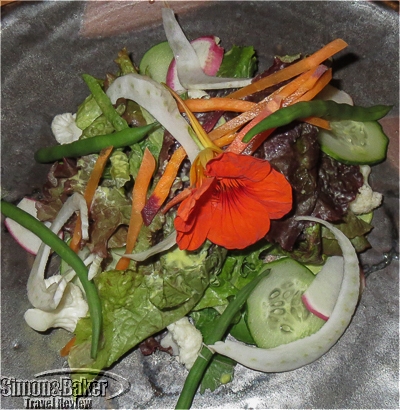
The salad of local greens and herbs
The first thing we noticed was the minimalist décor with an open kitchen in the back of the single space and the warm welcome (Dylan and Timothy looked after us) and ambiance. Wood floors and few adornments lent it a streamlined functional appearance. The armless seats were less than comfortable, and by the end of the meal we were eager to leave just to part company with the seats. In the rear there was a unisex bathroom.
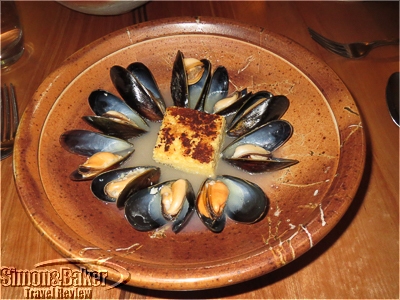
The mussels with polenta
The menu featured multi-plate options as well as an 18-item tasting menu, and wine pairings. On our first visit, we sampled the multi-plate menus. For the following dinner, we opted for the Tasting Menu with wine pairing to get a broad sampling of the cuisine and celebrate a special occasion. Wines were biodynamic, natural (unfiltered, wild fermented and without sulfites) or wild fermented.
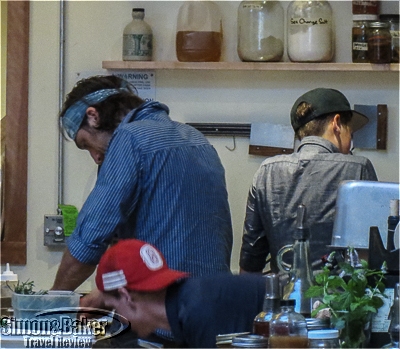
The open kitchen allowed diners to watch the chef and his staff at work
From Beet chips served with crispy beets, chevre cheese and micro greens to the messy but nice mascarpone Buckwheat Fennel Seed Cookies at the end, and the Austrian, French, and Italian wines by the glass paired to the menu we had a most enjoyable and unique dinner.
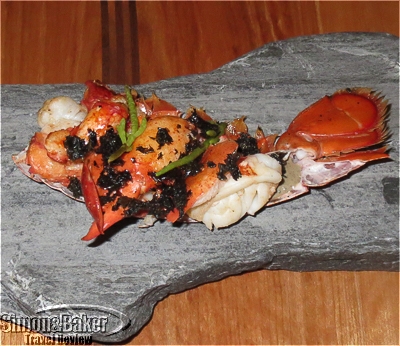
Locally sourced lobster served on a stone platter
As the evening progressed the dining room filled and the noise level grew. Staff became busier although we were not neglected. We appreciated our meals at Vinland and look forward to dining there again the next time our travels take us to Portland.
Well prepared fresh fish, regional products, diverse settings made Nevis dining rewarding
Article and photos by Elena del Valle
One of my favorite spots to sit at breakfast at Montpelier Plantation and Beach
During my five night stay in the beautiful Caribbean island of Nevis, in the West Indies, I was impressed by the surprising number of good meals I enjoyed, especially for an island of that size. While there I had a chance to eat at eight venues. Whether in one of many informal eateries, at a fine dining restaurant, on a hill setting or beach side the quality of the meals and dexterous preparation was notable.
One of my dinner courses at Restaurant 750 at Montpelier Plantation and Beach
Seeking local or regional ingredients and fresh produce I often favored simply prepared fish in lieu of classic European dishes made from products that had previously been frozen. I particularly appreciated the availability of fresh caught fish and the chefs’ ability to prepare it well. Almost without exception every fish dish I ordered was made to highlight its flavor and texture without overwhelming it with exotic (to the island) or excessive spices and garnishes.
An appetizing main course at Restaurant 750 at Montpelier Plantation and Beach
Stephane Caumont, French executive chef at Montpelier Plantation and Beach
My first meal on the island was at Restaurant 750 at the Montpelier Plantation and Beach (+1 869 469 3462, info@montpeliernevis.com), the lovely hillside hotel where I stayed. Camera shy owner and operator Muffin Hoffman was a behind the scenes presence at the restaurant headed by Stephane Caumont, a newly arrived French executive chef, which offered “a blend of French and Caribbean cuisine with emphasis on fresh, innovative food.” I looked forward to the combination buffet and prepared to order breakfast every morning.
The Sea Breeze Beach Bar at Nisbet Plantation Beach Club
My fresh caught kingfish with a side salad and Nisbet Chips at Sea Breeze Beach Bar
The next day I had a delicious beach side lunch at Sea Breeze Beach Bar at Nisbet Plantation Beach Club (+869 469-9325, NisbetPlantation.com, reservations@nisbetplantation.com). The shaded setting two steps from the sand was comfortable thanks to cooling breezes. I tasted wonderfully prepared fresh caught kingfish served with a side salad and Nisbet Chips, made from thin slices of tania, sweet potato and breadfruit. I had a fresh fruit smoothie without sugar (at my request) and for dessert I tried the coconut panna cotta with fresh melon, strawberries, pineapple and starfruit. Glendina, our friendly server, was accommodating and had a ready smile. The toes in the sand beachfront dining service was available for snacks and lunch. The property, owned by David Dodwell, was managed by Alistair Forrest, general manager, who greeted us soon after we were seated.
For an appetizer I tried the pumpkin fritters with sweet and sour chili sauce at the Lime Beach Bar.
My spiny lobster at the Lime Beach Bar (click to enlarge)
Dinner that evening was at another beach location although I didn’t realize it until several days later. At the Lime Beach Bar (Pinneys Beach, + 869-662-9620, + 869-469 1147, limetourskn@gmail.com) I had pumpkin fritters with sweet and sour chili sauce for an appetizer. I also had a mixed salad with lettuce, feta cheese, watermelon slices and fried zucchini and eggplant pieces followed by a spiny lobster with rice and peas. Randy Jeffers, a local entrepreneur, owned the popular restaurant that served West Indian style cuisine.
My fresh fish lunch at the Oualie Beach Restaurant at Oualie Beach Resort
My fresh fish lunch at the Oualie Beach Restaurant Oualie Beach Resort (Oualie Bay, + 869-469-9735, www.oualiebeach.com, reservations@oualiebeach.com) was outstanding. Although there was outdoor seating we chose an indoor table in the shade. The beach front restaurant was owned by John and Alastair Yearwood and managed by Faith Bertie. Our server was friendly and attentive.
The sweet Killer Bee signature drink at Sunshine’s Beach Bar & Grill packed a punch (pun intended).
My fresh fish sandwich with fries and a side salad at Sunshine’s Beach Bar & Grill
During lunch at Sunshine’s Beach Bar & Grill (Pinneys Beach Bar & Grill, + 869-662-8817, + 869-469-5817, www.sunshinesbeachbar.com), another beach side restaurant (steps away from the Lime Beach Bar), we were greeted by a smiling Llewellyn “Sunshines” Caines, the owner. The bright interior was chock full of celebrity photos and international flags. West Indian and seafood dishes were on offer. I had another well prepared fresh fish in a sandwich while sitting in the shade steps from one of the island’s best known beaches. I tasted The Killer Bee, a deceptively tasty rum punch drink well known on the island.
A shared appetizer medley of local specialties at Bananas Bistro (click to enlarge)
A pasta and seafood main course at Bananas Bistro (click to enlarge)
For local and international cuisine we went to Bananas Bistro (Hamilton Estate, + 869-469-1891, www.bananasbistro.com, gsmith@sisterisles.kn), a hilltop see and be seen dress up dining venue owned by Gillian Smith, a world traveler turned restauranteur. I liked the romantic rooftop views of the island at sunset and the varied rum offerings.
While awaiting my spa treatments at The Spa at Four Seasons Resort Nevis (P.O. Box 565, Pinney’s Beach, Charlestown, Nevis, + 869 469-1111, http://www.fourseasons.com/nevis/spa, SpaConcierge.NEV@fourseasons.com) I had a spa lunch consisting of a bento box with fresh fish and a smoothie. It was so good I would return just for lunch.
A tasty dinner under the stars at The Rocks at Golden Rock Inn
The beautiful dinning room at The Rocks at Golden Rock Inn
Dinner at The Rocks at Golden Rock Inn (Golden Rock, Gingerland, + 1 869 469 3346, www.goldenrocknevis.com, info@goldenrocknevis.com), owned by Brice and Helen Marden and run by Peter Dunning, was a delight. We sat under the stars facing the hotel’s striking water features and enjoyed another outstanding Nevisian meal refreshed by cooling Caribbean breezes. I had a veggie tart amouse bouche followed by beet and citrus salad, and perfectly prepared fresh red snapper with wilted spinach, sweet potato wedges and red pepper coulis for the main course. Key lime pie rounded out the meal. Jocelyn, our server, was friendly and extra helpful. The beautiful and romantic setting combined with the delicious dinner made it one of my favorite restaurants.
Avocado Mousse with Shrimp, Greens and Mustard Vinaigrette
Pan-seared Mahi Mahi Fillet, roasted Pineapple and Cilantro Sauce

Richard Lupinacci, co-owner and manager The Hermitage Plantation
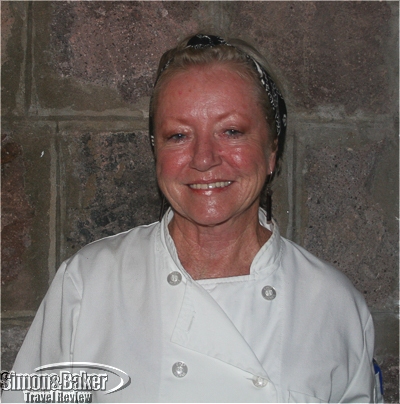
Chef Janice Ryan, The Hermitage Restaurant at The Hermitage Plantation
My final meal on the island was at The Hermitage Restaurant at The Hermitage Plantation (Hermitage,+ 869 469 3477, www.Hermitagenevis.com, Contactus@Hermitagenevis.com), an island estate rebuilt from ruins and owned by Maureen and Richard Lupinacci. I had the pleasure of meeting and dining with Richard Lupinacci, the property’s affable manager. The restaurant specialty was Caribbean gourmet, prepared by Chef Janice Ryan.
Tiny Left Bank gourmet shop where savvy Parisian cooks can get their secret ingredients
Article and photos by Josette King
A discrete sign guided visitors to the internal courtyard where the shop was located.
Epiceries fines (gourmet shops) are hard to miss in Paris, France. They range from vast food halls that offer all manner of desirable foodstuff from around France and far beyond, to boutiques specializing in a specific indulgence: caviar, cheese, smoked salmon, chocolate or macarons to name a few. You name it and any self-respecting Parisian will give you at least a couple of bonnes adresses (top places where you are sure to satisfy your particular yearning). Many of these epicurean temples have been in business for well over a century and have achieved the status of local institutions on the checklist of foodie tourists from every corner of the planet.
Unassuming doors led to a treasure trove of delicacies from the French heartland.
Then there are adresses confidentielles, exceptional places to be shared only as a favor to someone’s friends. Tomat’s (12 Rue Jacob, 75006 Paris, France. +33 1 44 07 36 58. www.tomats.fr), a tiny gem tucked in a 17th century courtyard in the heart of Saint Germain des Prés rates high on my list of the latter. Barely a decade old, its unique appeal is rooted in the passion of its owner-manager Alexandra Blanchet de Pudhot for the traditional delicacies of the French heartland. She was proud to point out that 95 percent of her inventory comes from small French producers. She also featured a few outstanding Italian treats, such as her coarse fresh Genovese Pesto so delicious that one of my friends has taken to slathering it on toasted country bread.
Tomat’s owner-manager Alexandra Blanchet de Pudhot
In addition to a broad array of the essentials that great pantries are made of, she also sourced exceptional seasonal specialties. At the time of my early fall visit she had just received a fish and crawfish terrine from the Loire Valley that was otherwise only available at the producer’s. And in anticipation of the holiday season her inventory was being enhanced with attractive assortments of exotic spices each with a cookbook included, as well as new kinds of truffled foie gras, duck confits and traditional goose sausages from the South West of France that I expect will star in my gourmet gift baskets. Alexandra had tasted approximately 80 percent of the products carried at Tomat’s. Her associate was charged with tasting the remainder, such as artisan jams and honeys, the full range of the peerless Bonnat chocolate bars, and other sweets. Products that have become permanent staples of the inventory were re-sampled periodically to ensure that the high quality remained constant.
A tasting of artisanal Huiles LeBlanc
At Tomat’s the emphasis on personal contact was as exceptional as the products on the shelves. Alexandra clearly enjoyed discovering her customers’ tastes to better offer suggestions on what could delight them and enhance their recipes, making her épicerie the sort of place where savvy cooks get their “secret ingredients.” In my case recently, one such find was a small pot of Beaume de Casanova, an exquisite bitter chocolate and ginger mustard, a few dabs of which had my guest raving over a simple roasted chicken. I had not suspected such a thing existed until my visit to Tomat’s. Nor had I heard of Huiles LeBlanc, a wide range artisan oils from Burgundy.
The shelves were brimming with the makings of a great pantry.
The family-owned and operated enterprise has extracted exceptional virgin oils from a variety of products from pistachio, pine and hazelnuts to marrow pits for well over a century. In Paris, they could be found at Tomat’s exclusively. I was a bit dubious at some of the most esoteric concoctions such as oil from the nut found inside the pit of prune plums, until I had a taste of several of them. In all cases, it had a more subtle, smoother taste than the nut itself. Their pistachio oil is my new favorite to drizzle over seared scallops and poached mild white fish. As for the prune plum nut oil? A few teaspoons transformed a humble autumn fruit compote into an intriguing dessert. I have also been known to use it as a dipping oil for bits of day-old brioche.
An attractive assortments exotic spices made original gifts
With its exceptional variety of unusual products, personalized service and this not insignificant detail, friendly prices, Tomat’s has become a frequent stop for me, just in case a new interesting something has come in. It usually has.


